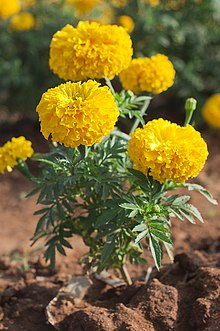| Marigold | |
|---|---|

| |
| Tagetes erecta | |
| Scientific classification | |
| Kingdom: | Plantae |
| Clade: | Tracheophytes |
| Clade: | Angiosperms |
| Clade: | Eudicots |
| Clade: | Asterids |
| Order: | Asterales |
| Family: | Asteraceae |
| Subfamily: | Asteroideae |
| Tribe: | Tageteae |
| Subtribe: | Pectidinae |
| Genus: | Tagetes L.[1] |
| Synonyms | |
| |
Tagetes (/tæˈdʒiːtiːz/) is a genus[3] of 50 species of annual or perennial, mostly herbaceous plants in the family Asteraceae. They are among several groups of plants known in English as marigolds. The genus Tagetes was described by Carl Linnaeus in 1753.[4][5]
Originally called cempōhualxōchitl, by the Nahua peoples, these plants are native to Central and Southern Mexico and several other Latin American countries. Some species have become naturalized around the world. One species, T. minuta, is considered a noxious invasive plant in some areas.[3]
- ^ "Genus: Tagetes L." Germplasm Resources Information Network. United States Department of Agriculture. 2011-01-06. Archived from the original on 2012-03-09. Retrieved 2011-07-14.
- ^ "Tagetes L. | Plants of the World Online | Kew Science". Plants of the World Online. Retrieved 2024-05-02.
- ^ a b Soule, J. A. 1996. Infrageneric Systematics of Tagetes. Pgs. 435-443 in Compositae: Systematics, Proceedings of the International Compositae Conference, Kew 1994, Vol. I, Eds. D.J.N. Hind & H.J. Beentje.
- ^ Linnaeus, Carl von. 1753. Species Plantarum 2: 887 in Latin
- ^ "Tropicos | Name - !Tagetes L." www.tropicos.org.